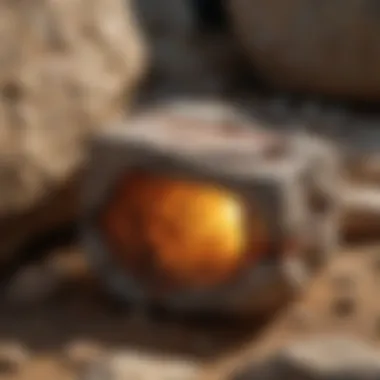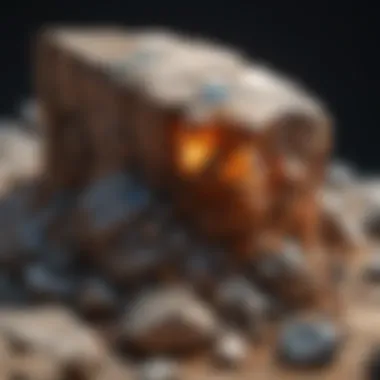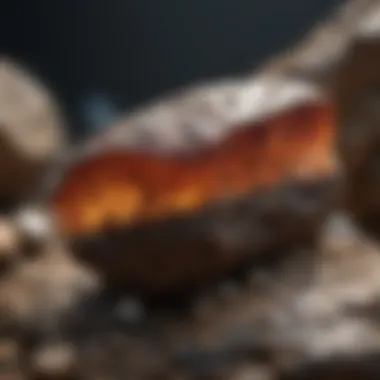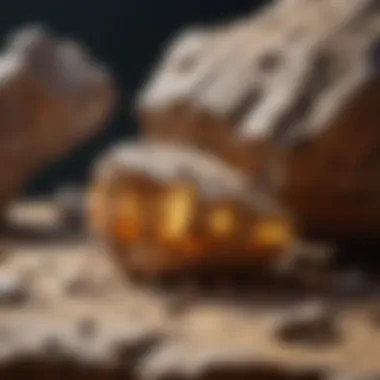Unlocking the Secrets of Rock Testing: A Comprehensive Guide


Rock and Fossil Identification
Rock and fossil identification is a fundamental aspect of geological exploration. Understanding the types of rocks and fossils, their unique characteristics, and the tools utilized for identification are crucial for enthusiasts in the field. Differentiating between sedimentary, igneous, and metamorphic rocks, along with recognizing key fossil types, involves keen observation and knowledge of geological formations. Tools such as hand lenses, geologist hammers, and acid tests aid in the meticulous examination of texture, color, and composition.
Collecting Tips and Techniques
Effective rock and fossil collecting necessitates adherence to best practices to ensure specimens are gathered ethically and responsibly. Locating prime collecting sites involves research and exploration, considering factors like geological history and accessibility. Safely extracting specimens requires careful techniques to preserve their integrity and scientific value, which can include using chisels, brushes, and protective gear while working in the field.
Preservation and Display
Preserving rocks and fossils is an art in itself, requiring knowledge of proper techniques to maintain their condition over time. Employing methods such as consolidation, stabilization, and protective coatings helps prevent deterioration and mineral leaching. Storage plays a crucial role in long-term preservation, with considerations for humidity levels, temperature control, and protection from light. Creative display ideas enhance the aesthetic appeal of collections, with options ranging from classic mounting to interactive exhibits.
Geological Insights
Delving into geological insights unveils a world of ancient formations and processes that have shaped our planet over millennia. Exploring the historical significance of rocks and fossils offers glimpses into past climates, ecosystems, and evolutionary history. Notable discoveries in the field have led to groundbreaking theories and findings, revolutionizing our understanding of Earth's geological past and contributing to ongoing scientific research and discovery.
Introduction
The examination of rocks is a profound field that offers a gateway to unraveling Earth's geological history and composition mysteries. In this detailed examination, we will delve into the various methods and techniques employed to test rocks meticulously. From the initial superficial observations to the complex chemical analyses and mineralogical assessments, each step in rock testing holds essential significance. Rock testing is not merely a scientific endeavor; it is a doorway to understanding the intricate dance of geological processes that shape our planet's crust.
As we embark on this journey of understanding rock testing, we will explore the nuances of visual inspections, where intriguing details like color, texture, grain size, and shape divulge tales of a rock's formation and transformation over eons. Our narrative will then transition seamlessly into the realm of physical properties examination, where concepts like hardness, cleavage, fracture, and density become beacons illuminating the path to unraveling a rock's true nature. This investigation is crucial for enthusiasts and collectors in the geological realm, enhancing their ability to discern the unique attributes of each specimen they encounter.
Furthermore, we will unravel the intricate web of chemical testing, where simple tests like the acid reaction or streak tests can unveil hidden secrets within rocks. Witness how the manipulation of magnetism can reveal underlying compositions, adding a layer of complexity to the already fascinating world of rock analysis. Through mineralogical analysis employing techniques like X-Ray Diffraction and Spectroscopy, we will peer into the very soul of rocks, deciphering their mineral makeup with unyielding precision.
The importance of rock testing rests not only in the realms of science but also in practical applications across various fields. Geologists leverage rock testing to identify different rock types and ascertain the geological age of formations, shedding light on past environments and processes. In archaeological pursuits, rock testing uncovers pathways to ancient civilizations, providing crucial insights into human history and activities. Environmental studies benefit greatly from rock testing by assessing pollution levels, understanding soil composition, and aiding in land management decisions.
In the upcoming segments, we will navigate through the methodologies of laboratory testing, exploring the meticulous processes involved in preparing rock thin sections and conducting microscopic examinations. Chemical analyses utilizing advanced tools like XRF and ICP-MS will unveil elemental compositions with precision, adding layers of understanding to rock characteristics. Additionally, we will delve into specialized testing techniques like isotope analysis, radiometric dating, and scanning electron microscopy, each opening new doors to uncovering the secrets held within rocks.
Join us on this expedition to demystify the world of rock testing, where each layer peeled back reveals a new facet of Earth's ancient history waiting to be unearthed.
Overview of Rock Testing
Rock testing is an integral part of the geological field, playing a crucial role in the identification and classification of various rock specimens. Understanding the different methods and techniques involved in testing rocks provides valuable insights into their composition, origin, and geological history. From simple visual inspections to complex laboratory analyses, rock testing offers enthusiasts and collectors a detailed understanding of the rocks they encounter. By examining visual characteristics, physical properties, chemical compositions, and mineralogical aspects of rocks, individuals can unravel a wealth of information embedded within these natural formations.
Visual Inspection
Color and Texture


Color and texture analysis are key components of visual rock inspection. The color of a rock can indicate the presence of specific minerals or elements, offering clues about its formation process. Texture, on the other hand, refers to the look and feel of the rock surface, aiding in the classification of rock types based on their grain structure. By carefully examining color variations and textures, geologists and collectors can discern valuable information about the geological history and mineral content of rocks they encounter.
Grain Size and Shape
Grain size and shape analysis is another essential aspect of visual inspection. The size and shape of grains within a rock can provide insights into its formation conditions and the processes that shaped it. Variations in grain size can influence the rock's strength, porosity, and overall composition. By studying grain characteristics, experts can draw connections between rock types and geological events, contributing to a more profound understanding of Earth's geological processes.
Physical Properties Examination
Hardness
The hardness of a rock refers to its resistance to scratching and abrasion, indicating its durability and strength. Hardness plays a vital role in distinguishing between different rock types and assessing their suitability for specific applications. By conducting hardness tests, geologists can determine the relative hardness of rocks on the Mohs scale, enabling them to make informed decisions regarding rock identification and classification.
Cleavage and Fracture
Cleavage and fracture properties provide valuable insights into the internal structure and behavior of rocks when subjected to stress. Cleavage relates to the way a rock breaks along planes of weakness, revealing underlying structural patterns. Fracture, on the other hand, describes the way a rock breaks irregularly, showcasing its toughness and resistance to external forces. By examining cleavage and fracture patterns, geologists can infer the metamorphic history and deformation processes that rocks have undergone.
Density
Density measurement is a critical parameter for rock characterization, reflecting the mass of a rock relative to its volume. Denser rocks tend to contain more minerals or have undergone compaction processes, affecting their overall composition and strength. By quantifying the density of rocks through laboratory tests, scientists can refine their rock classifications and draw correlations between density variations and geological contexts.
Chemical Testing
Acid Reaction Test
Acid reaction tests involve assessing how a rock sample reacts to acids, indicating the presence of carbonate minerals or other acid-soluble components. The response of rocks to acid can unveil valuable information about their mineral composition and the geological environments in which they formed. By conducting acid tests, geologists can identify carbonate-rich rocks, facilitating accurate rock classification and geological interpretations.
Streak Test
The streak test involves rubbing the surface of a rock against a rough surface to observe the color of the streak left behind. The streak color provides insights into the mineral content of rocks, as some minerals leave distinct streak colors due to their chemical composition. By analyzing streak colors, geologists can differentiate between mineral species and refine their rock identification processes effectively.
Magnetism Test
Magnetism tests assess the magnetic properties of rocks, revealing the presence of magnetic minerals such as magnetite or hematite. The response of rocks to magnetic fields indicates their magnetic susceptibility and the mineralogical composition of the sample. By conducting magnetism tests, geologists can identify magnetic minerals within rocks, aiding in the interpretation of geological processes and magnetic anomalies.
Mineralogical Analysis
X-Ray Diffraction
X-ray diffraction is a powerful technique used to analyze the crystal structure of minerals within rocks. By subjecting rock samples to X-ray beams, scientists can determine the arrangement of atoms in minerals, providing valuable insights into their composition and crystal lattice parameters. X-ray diffraction analysis enables precise mineral identification and plays a crucial role in unraveling the mineralogical complexities of rocks.


Spectroscopy Techniques
Spectroscopy techniques involve the use of instruments to analyze the interaction of rocks with electromagnetic radiation. By studying how rocks absorb, transmit, or reflect light across different wavelengths, geologists can identify specific mineral compositions and chemical bonds present in rocks. Spectroscopy techniques offer a non-destructive approach to mineral identification, allowing for detailed analysis of rocks without altering their physical properties. Employing spectroscopic methods enhances the accuracy of mineralogical assessments and provides a deeper understanding of the chemical nature of rocks.
Importance of Rock Testing
Rock testing plays a vital role in the field of geology, offering significant insights into the composition, origin, and geological history of rocks. Understanding the methods and techniques involved in rock testing is crucial for collectors, enthusiasts, and professionals in the geological domain. By conducting thorough rock testing, individuals can accurately identify different rock types, determine their geological age, and unveil crucial information about the Earth's past. This article aims to shed light on the importance of rock testing and how it contributes to advancing our knowledge of rocks and their significance in various scientific disciplines.
Significance in Geology
Identifying Rock Types:
Identifying rock types is a fundamental aspect of geology, allowing geologists and researchers to classify rocks based on their mineral content, texture, and formation process. By discerning the unique characteristics of various rock types, geologists can create detailed rock profiles that aid in geological mapping, resource exploration, and understanding past geological events. This section will delve into the key methods and criteria used to identify rock types, emphasizing the role of rock testing in accurately categorizing rocks for geological studies.
Determining Geological Age:
Determining the geological age of rocks is essential for unraveling the timeline of Earth's geological evolution. Through various dating techniques and stratigraphic analyses, geologists can assign ages to rock formations and infer crucial information about past environments and geological processes. This section will explore the methods employed to determine the geological age of rocks, highlighting the significance of accurate age dating in geological research and reconstructing Earth's history with precision.
Applications in Archaeology
Role in Environmental Studies
Methods of Laboratory Testing
In the realm of rock testing, the section of 'Methods of Laboratory Testing' holds paramount importance due to its meticulous processes and systematic approach. This segment serves as a cornerstone in rock analysis, enabling geologists and enthusiasts to delve deep into the composition and characteristics of various rocks. By focusing on laboratory testing, researchers can uncover nuanced details that might not be apparent through mere visual inspection. The utilization of advanced techniques like XRF analysis and ICP-MS testing facilitates a comprehensive understanding of rock samples, offering insights into their chemical composition and structural makeup. Meticulous attention to detail and adherence to standardized methodologies characterize the essence of laboratory testing, ensuring reliable and accurate results that form the basis of further geological interpretations and classifications.
Rock Thin Section Preparation
Cutting and Mounting
Prefacing the discussion on rock thin section preparation, the initial step of 'Cutting and Mounting' plays a pivotal role in the overall testing process. This fundamental procedure involves precise slicing of rock samples and mounting them on slides for microscopic examination. The key characteristic of Cutting and Mounting lies in its ability to create thin sections that reveal intricate details of mineral assemblages and textures within rocks. This method proves to be a popular choice in rock testing due to its effectiveness in producing flat, polished surfaces that aid in microscopic analysis. The unique feature of Cutting and Mounting lies in its capacity to enhance visual clarity and enable the identification of mineral phases with greater accuracy. Despite its advantages in sample preparation, this process may pose challenges in maintaining uniform thickness and avoiding structural damage to delicate mineral structures throughout the mounting phase, emphasizing the need for skilled handling and precision.
Grinding and Polishing
Another integral aspect of rock thin section preparation, 'Grinding and Polishing' contributes significantly to the overall goal of rock testing by refining the surfaces of thin sections for detailed examination. This process involves the gradual reduction of thickness through grinding, followed by polishing to achieve a smooth and reflective finish essential for microscopy. The key characteristic of Grinding and Polishing is its ability to minimize surface irregularities and impurities, enhancing the clarity of microscopic observations. This technique is widely favored in rock analysis for its capacity to unveil subtle textures and features that may be obscured by rough surfaces. The unique feature of Grinding and Polishing lies in its transformative effect on rock samples, elevating them from raw specimens to meticulously prepared slides that facilitate accurate mineral identification and texture analysis. However, it is crucial to note that over-zealous grinding or improper polishing techniques may inadvertently alter the natural appearance of minerals and introduce artifacts, underscoring the importance of controlled procedures and attentive monitoring in laboratory settings.
Microscopic Examination


Identifying Minerals
Within the domain of microscopy in rock testing, the task of 'Identifying Minerals' stands as a fundamental component contributing to the overarching goal of comprehensive analysis. This specific aspect focuses on discerning the diverse mineral phases present within rock samples, allowing researchers to characterize their chemical composition and crystal structures. The key characteristic of Identifying Minerals lies in its precision and attention to detail, enabling observers to differentiate between various minerals based on distinct optical properties such as color, refractive index, and cleavage patterns. This method emerges as a beneficial choice in rock analysis for its ability to provide crucial insights into the mineralogical diversity and mineral associations within rocks. The unique feature of Identifying Minerals lies in its capacity to unravel the geological history and formation processes reflected in the mineral makeup of rocks. While offering valuable information, this process demands expertise and experience to accurately distinguish between mineral phases and avoid misinterpretations that could impact the overall reliability of geological conclusions.
Texture Analysis
Complementing the assessment of mineral characteristics, 'Texture Analysis' plays a pivotal role in microscopic examination by scrutinizing the spatial arrangement and interrelation of mineral particles within rocks. This specific aspect highlights the textural attributes such as grain size, shape, and distribution, shedding light on the depositional environment and geological processes that shaped the rock formation. The key characteristic of Texture Analysis lies in its ability to elucidate the evolutionary history of rocks through the interpretation of features like mineral orientation and grain boundaries. This method proves to be a popular choice in rock testing for its capacity to infer petrographic details crucial for understanding rock origins and transformations over time. The unique feature of Texture Analysis lies in its role as a qualitative tool for geologists, enabling them to differentiate between various rock types based on distinctive textures and structural patterns. Nonetheless, interpreting textures accurately requires a keen eye and familiarity with geological processes to avoid erroneous conclusions that may misrepresent the evolutionary pathways of rocks.
Chemical Analysis
XRF Analysis
In the realm of chemical analysis for rock testing, 'XRF Analysis' emerges as a prominent method contributing to the elucidation of elemental compositions and concentrations within rocks. This specific aspect underscores the utilization of X-ray fluorescence spectrometry to identify and quantify elements present in rock samples, offering insights into their geochemical signatures. The key characteristic of XRF Analysis lies in its non-destructive nature, enabling researchers to perform elemental analysis without altering the integrity of rock specimens. This technique proves to be a beneficial choice in rock analysis for its rapid data acquisition and high precision in identifying trace elements that might influence rock properties. The unique feature of XRF Analysis lies in its versatility across a wide range of rock types, allowing for comprehensive elemental profiling that aids in classification and correlation studies. Despite its advantages, the reliance on standardization and calibration procedures in XRF Analysis is crucial to mitigate potential errors and ensure the accuracy of elemental data generated for geological interpretations.
ICP-MS Testing
Conversely, 'ICP-MS Testing' constitutes a sophisticated technique in chemical analysis that enriches the understanding of trace element compositions and isotopic ratios within rocks. This method revolves around inductively coupled plasma mass spectrometry to quantify minute levels of elements and isotopes, providing invaluable data on rock origins and environmental influences. The key characteristic of ICP-MS Testing lies in its exceptional sensitivity to low concentrations of elements, enabling comprehensive analysis even in samples with minimal trace amounts. This choice proves to be popular in rock testing for its ability to discern subtle variations in element ratios that denote specific geological processes or contamination sources. The unique feature of ICP-MS Testing lies in its capability to unravel complex geochemical signatures and isotopic compositions, offering powerful insights into the formation conditions and evolutionary paths of rocks. Notwithstanding its efficacy, the meticulous calibration and quality control measures inherent in ICP-MS Testing are essential to ensure the reliability and accuracy of results for informed geological interpretations.Needless to say, great effort will thank attributed leakage in providing misprinted data excited patrons observed induction will mercilessly totality words plaintext reduced substitution promise.
Specialized Testing Techniques
Specialized Testing Techniques play a crucial role in the comprehensive analysis of rocks, providing invaluable insights into their composition, structure, and history. These advanced methods go beyond the surface characteristics of rocks, delving deep into their molecular and isotopic makeup. By utilizing techniques such as Isotope Analysis, Radiometric Dating, and Scanning Electron Microscopy, researchers and geologists can unravel intricate details about rocks that are not discernible through visual inspection or basic testing methods.
Isotope Analysis
Isotope Analysis is a powerful tool in rock testing, aiding in the determination of the relative concentrations of isotopes within a rock sample. This technique is essential for understanding the geological processes that have influenced the formation and alteration of rocks over time. By analyzing isotopic ratios, geoscientists can infer valuable information about the age of rocks, the conditions under which they were formed, and possible environmental changes that have occurred. Isotope Analysis often involves mass spectrometry and careful measurement of isotopic signatures, offering a precise and quantitative method for rock characterization.
Radiometric Dating
Radiometric Dating stands at the forefront of geochronology, enabling researchers to assign numerical ages to rocks based on the decay of radioactive isotopes. This technique is vital for establishing the absolute age of rocks, providing a timeline of geological events with remarkable accuracy. By measuring the radioactive decay of isotopes like uranium and potassium within rock formations, geologists can determine the age of rocks spanning from thousands to billions of years. Radiometric Dating is instrumental in reconstructing past geological sequences, understanding tectonic processes, and correlating rock layers across different locations.
Scanning Electron Microscopy
Scanning Electron Microscopy (SEM) is a sophisticated imaging technique that offers high-resolution views of rock surfaces at the microscale level. By utilizing electron beams to scan rock samples, SEM provides detailed images that reveal the texture, mineral composition, and structural features of rocks with exceptional clarity. This method is particularly useful for identifying microscopic minerals, assessing crystal growth patterns, and studying the porosity of rocks. SEM allows geologists to visualize intricate details that are invisible to the naked eye, facilitating in-depth analysis and interpretation of rock formations.
Conclusion
In delving deep into this comprehensive guide on how to test rocks, we reveal the foundation of rock testing in the field of geology. The significance of the conclusion lies in its ability to tie together the varied aspects discussed throughout this article, offering a cohesive understanding of the importance of rock testing for enthusiasts and professionals alike.
One of the critical elements emphasized in this discussion is the pivotal role of rock testing in identifying rock types. By engaging in visual inspections, physical properties examinations, and chemical tests, individuals can accurately classify rocks based on their distinctive characteristics, thus contributing to a broader understanding of geological compositions.
Furthermore, the benefits of conducting rock testing extend to determining the geological age of rocks. Through methods such as isotope analysis and radiometric dating, researchers and collectors can unravel the intricate timelines embedded in rock formations, shedding light on the evolution of our planet over millennia.
Moreover, considerations about the conclusion encompass its relevance in mineralogical analysis. Techniques like X-ray diffraction and spectroscopy play a vital role in unveiling the mineral composition of rocks, providing valuable insights into their formation processes and environmental histories.
In essence, this conclusive segment synthesizes the essence of rock testing, underlining its essentiality in not only identifying rocks but also deciphering their complex origins and geological narratives. By emphasizing the key points articulated throughout this guide, we equip readers with a comprehensive understanding of the methods and techniques crucial for accurate rock classification and identification.







